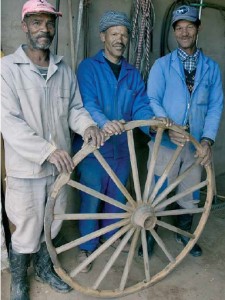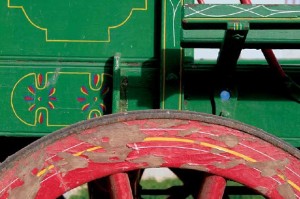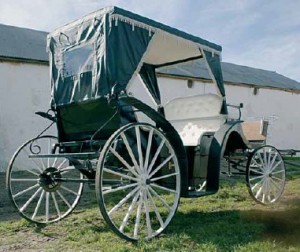
Piet Serdyn
Farmer Piet Serdyn of Kleinkarnmelksvlei near Moorreesburg in the Swartland is one of the last of a nearly extinct breed, the old-fashioned wagon-maker and wheelwright. Few, if any, can match his skill in restoring old carts and wagons to their original glory.
Most of the ox wagons used by transport riders throughout Southern Africa during the nineteenth century especially on the Great Trek as well as to the gold and diamond fields were built in the Cape. The raw materials as well as the expertise were available at the Cape, whereas most of the basic finer construction knowledge had been imported from Europe.
Using age-old skills, Piet builds and restores wagons and carts using modern materials. He recently built a beautiful black cano-landau with steel wheels, white genuine leather upholstery and fringes around the top which took him more than two hundred hours to finish. “But,” he maintains, “nothing excites me more than the sight of an old wagon-wheel, broken and paint flaking, begging for its dignity to be restored. And nothing beats the feeling when you push the final product out into the sun. An old wreck has been turned into a shining chariot. You look at your hands and you know: I’ve done it, with these hands, I’ve done it ! You’re proud and humble at the same time.”
Piet remembers well the days when he and his siblings went to school at Bridgetown in a cart drawn by one horse, come rain or shine. When it was raining his father would put two horses in front of the cart, that way they could get to school quicker !
While Piet was still in the sub-standards and had to wait for his sisters in the higher grades who came out later, he would go and watch the local wagon-maker working at his trade. Whilst still a young farmer in his early twenties, literally by accident, and without realizing it then, Piet’s life work found him. A certain Mr Faan du Toit who came from Caledon and used to restore wagons, lost four of his fingers while working on a wagon, and he asked Piet to help him finish the job. Piet continued helping him with the designs and some of the other work and after Mr du Toit’s death, the people kept on coming to Piet. Eventually, after many years of farming, his hobby became his work. Now farming is his hobby, says Piet, who still lives on the farm where he was born.

Carriage Wheel
“It takes a long time to build a wagon. One wheel can take longer than a week”, says Piet. “Each of the fourteen spokes is cut from solid wood and then carved into the right shape and size. It’s precision work, because the spoke must fit perfectly into the hub at the centre and into the rim on the perimeter. After assembling the wheel, the spokes and hub are attached and the outer rim is added. Everything is done by hand as in the old days and is the work of a craftsman with an inborn skill, because not every carpenter is capable of making good spokes and wheels”.
“A wheel needs to be assembled in a way that will distribute the strain evenly. It is a craft where the experienced eye achieves more than the rule, so that when the rim is put on, the contraction gives just the right effect. A wheelwright, in fact, sees the wheel as a whole while he builds it; and that is not an art to be learnt in a day. A wagon-maker also needs to know his wood”, says Piet. “The wood must not have knots and must be tough enough to carry heavy loads and withstand knocks and chipping, but it must also be flexible enough to absorb shocks. Early wagon-makers used waboom, cedar, assegai, yellow and stinkwood. It takes about 1500 kg of wood to build one wagon! Due to the scarcity and the high cost of these woods today, Piet uses oak for the spokes and oregon pine and hickory, imported from America, for the rest.

Workers
Three of Piet’s team of workers, Jan Adams, Moos (Bollie) Boois and Thomas Daniels, without whom he couldn’t do this work, are quick to say that Piet taught them everything they know about wagon and wheel making. Most of the work is done in barns on the farm.

Paint Job
Piet says that the Cape Coloureds and the Malays were some of the best wagon-makers with a long history in the crafts of tanning, upholstery and painting. The Malays were especially known as painters of wagons and they were indispensable to the industry, with everything on a wagon being painted, no matter how rare, beautiful or expensive the wood of which it is made. That’s the tradition. And only certain colours are used; dark green, post box red, sky blue, dark brown and sometimes a little white.
Every wagon-maker had his own painter, because apart from his name on the axle of the wagon, he had his own trademark in painting too, normally some flowery or feather pattern. Piet’s trade-mark is a fish. After weeks of painting, the product is varnished again and again until it shines like glass.
Apart from the occasional donkey-cart, wagons and carts that were the only means of transport in South Africa for almost three hundred years have vanished from our roads. Yet most people over the age of fifty, be it here or anywhere else in the world, still have memories of some sort of animal-powered vehicles; wagons used for living in or transport, donkey carts, or the more “classy” hansoms, cabs, buggies, spiders, landaus, tilburies, carriages and post coaches….

Cano Landau
“The wagons and donkey carts were the “bakkies”, the workers, and normally drawn by oxen, mules and donkeys”, says Piet, “…and the rest were the “Mercedes’s”, taken out of the barn normally only on Sundays to go to church or visiting. For those, horses were inspanned”.
Jan van Riebeeck, founder of the settlement at the Cape of Good Hope, did not bring any carts or wagons with him. Built for use in a flat country with scarcely a rock or stone in it, they would in any case not have been of much use here! And in Holland they used horses to draw them, whilst here van Riebeeck had only oxen, which he was very reluctant to use at first.
As early as May 1652 van Riebeeck wrote in his journal that several fine beams and two masts from a wreck were washed ashore which could have been of great use to them if only they could get them to the fort. He concluded that carts would have to be made principally for the purpose of fetching salt.
In July 1653 he wrote that they were getting 2 or 3 beams every day from the forest, drawn by oxen on a two-wheeled carpenter’s cart, made locally and going along beautifully and easily. Every day a trip was made with two oxen, and they kept eight for that purpose, training them so that one could relieve another. A later entry reads that stone for the building of the fort at the Cape would be brought on a wagon which was made of wood obtained from the indigenous forest and which would be drawn by oxen. These early carts and wagons were modelled on the Dutch farmers’wagon, but stronger and sturdier. “ It is interesting”, says Piet, “that in van Riebeeck’s time the four wheels made up half the price of the wagon – which is still the case today”.
From 1657 wagons were built by blacksmiths and carpenters as no qualified wagon-builders had arrived at the Cape up to that point as yet. In 1659 a gunsmith, Jaspar de Berge arrived. When it came to light that his real profession was wagon-building, he was quickly put to his trade!

Front Wheel
As the population grew and farmers started moving inland, more and more wagons that were designed specifically for the varying conditions were built at the Cape. For example, the wagons used in the Overberg which had to go over very rocky and steep mountains carrying heavy loads of sometimes up to a 1000 kg, were heavier, and shorter sprung, compared to the lighter, longer and unsprung wagons of the Swartland where the countryside is more even. Almost every town and village in South Africa eventually had a wagon-maker or blacksmith.
Wagon and carriage-making turned into a big industry. At one stage there were forty-seven wagon-makers in Paarl alone ! The valley between Paarl and Wellington where the first wagon-maker set up his forge and workshop in the time of Governor Tulbagh became known as Val de Charron by which it is still known – Wagenmakersvallei.
In 1835 a certain Captain J E Alexander wrote a tribute to Cape wagon wheels which he found superior to the wheels then used by the British artillery, “Dutch wheels are made of three or four kinds of wood…the nave, yellow-wood; for the spokes, assegai; for felloe, red els or white pear. There are many more spokes than in our wheels, in all fourteen for a large and ten for a small. The tyre is put on in one piece and hot, so as to draw and bind the whole of the wheel firmly together. The wagon, too, is long and elastic and it is quite astonishing to an uninitiated observer what intense effort is employed in the building of Cape wagons without injury”.
Up to the 1820s the roads were nothing more than tracks and a journey in bad weather from Cape Town to Caledon could take up to thirteen days! Travelling in those days could be very dangerous and hazardous – as these roads were mostly bad, and especially after crossing a severely steep and rocky mountain pass or fording deep rivers with muddy beds, wagons often needed repairs.
Piet says almost every town and village had a “garage” – the blacksmith and his forge, and the wagon-builder and his work-shop. And believe it or not, reckless driving also took its toll ! Early in the 1700s the first laws were brought in to deal with “furious and negligent driving” and in 1798, under British occupation, all owners of carts and wagons had to paint their registered number, name and district on their vehicles and keep left when driving. When a wagon arrived within two miles of Cape Town, the oxen had to be led by a voorloper or touleier and eventually the cracking of whips in towns was also forbidden.
After the discovery of diamonds and gold, the overland traffic grew rapidly. More than two thousand loads of metal were transported from Paarl via the now forgotten highway to Kimberley when they started mining…a trip of almost six months.
During the first Witwatersrand gold rush more than sixteen thousand wagons left the railhead at Ladysmith in a year, loaded with picks and explosives, flour and blankets and the impatient gold-diggers themselves. The freight rates were so high that each journey paid the cost of the wagon!
The wagons built during this time were so strong that if they slipped off a rough track or capsized on a rocky mountainside, they were hauled back, new oxen were found and the journey was continued.

Trips ZA Logo
Call our Dream Merchants for exciting History, Wildlife, Scenic, or general Interest tours in the Panorama, Kruger, Lowveld regions or beyond on
013 764 1177.
Email us at johnt@tripsza.com

Hi Mr. Greef,
Thanks for your comments.
Unfortunately for Mr. Piet Serdyn I hear he’s since the article was written gone bankrupt & lost everything. The details I have gleaned will not be of use anymore.
The magazine Village Life who first printed the article has also gone under & folded.
My suggestion is that you contact the History Department of Cape Town University.
Someone there will help you I’m sure.